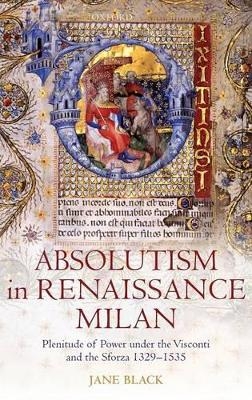
Absolutism in Renaissance Milan
Plenitude of Power under the Visconti and the Sforza 1329-1535
Seiten
2009
Oxford University Press (Verlag)
978-0-19-956529-0 (ISBN)
Oxford University Press (Verlag)
978-0-19-956529-0 (ISBN)
Black shows how authority above the law, once the preserve of pope and emperor, was seized, exploited, and eventually relinquished, by the ruling Milanese dynasties. Lawyers supported the free use of absolute power at first, but both sides eventually realized that society could not function unless property and other rights were respected.
Absolutism in Renaissance Milan shows how authority above the law, once the preserve of pope and emperor, was claimed by the ruling Milanese dynasties, the Visconti and the Sforza, and why this privilege was finally abandoned by Francesco II Sforza (d. 1535), the last duke.
As new rulers, the Visconti and the Sforza had had to impose their regime by rewarding supporters at the expense of opponents. That process required absolute power, also known as 'plenitude of power', meaning the capacity to overrule even fundamental laws and rights, including titles to property. The basis for such power reflected the changing status of Milanese rulers, first as signori and then as dukes.
Contemporary lawyers, schooled in the sanctity of fundamental laws, were at first prepared to overturn established doctrines in support of the free use of absolute power: even the leading jurist of the day, Baldo degli Ubaldi (d. 1400), accepted the new teaching. However, lawyers came eventually to regret the new approach and to reassert the principle that laws could not be set aside without compelling justification. The Visconti and the Sforza too saw the dangers of absolute power: as legitimate princes they were meant to champion law and justice, not condone arbitrary acts that disregarded basic rights.
Jane Black traces these developments in Milan over the course of two centuries, showing how the Visconti and Sforza regimes seized, exploited and finally relinquished absolute power.
Absolutism in Renaissance Milan shows how authority above the law, once the preserve of pope and emperor, was claimed by the ruling Milanese dynasties, the Visconti and the Sforza, and why this privilege was finally abandoned by Francesco II Sforza (d. 1535), the last duke.
As new rulers, the Visconti and the Sforza had had to impose their regime by rewarding supporters at the expense of opponents. That process required absolute power, also known as 'plenitude of power', meaning the capacity to overrule even fundamental laws and rights, including titles to property. The basis for such power reflected the changing status of Milanese rulers, first as signori and then as dukes.
Contemporary lawyers, schooled in the sanctity of fundamental laws, were at first prepared to overturn established doctrines in support of the free use of absolute power: even the leading jurist of the day, Baldo degli Ubaldi (d. 1400), accepted the new teaching. However, lawyers came eventually to regret the new approach and to reassert the principle that laws could not be set aside without compelling justification. The Visconti and the Sforza too saw the dangers of absolute power: as legitimate princes they were meant to champion law and justice, not condone arbitrary acts that disregarded basic rights.
Jane Black traces these developments in Milan over the course of two centuries, showing how the Visconti and Sforza regimes seized, exploited and finally relinquished absolute power.
Rulers of Milan 1287-1535 ; Introduction ; 1. Plenitude of Power: Absolutism in the Middle Ages ; 2. The Early Visconti and the Claim to Plenitude of Power ; 3. Giangaleazzo's Investiture and its Legacy ; 4. Lawyers and the Absolute Powers of the Duke ; 5. Plenitude of Power in Practice: The Problem of Preserving Justice while Infringing Rights ; 6. Lawyers and the Repudiation of Ducal Absolutism ; 7. Francesco II and the Surrender of Absolute Power ; Conclusion ; Appendices ; Bibliography
| Erscheint lt. Verlag | 8.10.2009 |
|---|---|
| Verlagsort | Oxford |
| Sprache | englisch |
| Maße | 164 x 242 mm |
| Gewicht | 560 g |
| Themenwelt | Geschichte ► Allgemeine Geschichte ► Mittelalter |
| Geschichte ► Allgemeine Geschichte ► Neuzeit (bis 1918) | |
| Geisteswissenschaften ► Geschichte ► Regional- / Ländergeschichte | |
| Recht / Steuern ► EU / Internationales Recht | |
| Recht / Steuern ► Öffentliches Recht ► Verfassungsrecht | |
| Recht / Steuern ► Rechtsgeschichte | |
| ISBN-10 | 0-19-956529-5 / 0199565295 |
| ISBN-13 | 978-0-19-956529-0 / 9780199565290 |
| Zustand | Neuware |
| Haben Sie eine Frage zum Produkt? |
Mehr entdecken
aus dem Bereich
aus dem Bereich
eine neue Geschichte des Mittelalters
Buch | Hardcover (2023)
C.H.Beck (Verlag)
CHF 53,20


